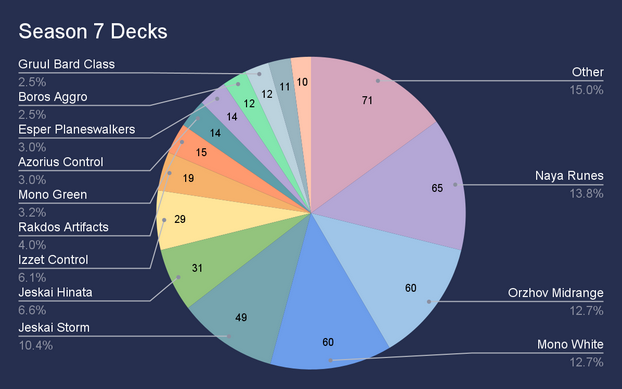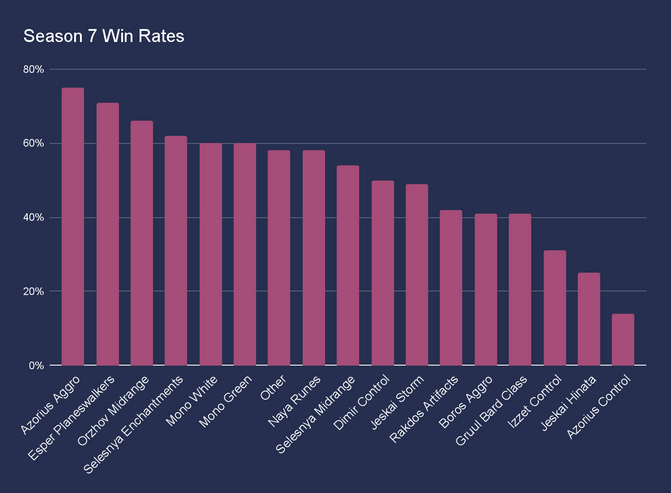Season 7 Metagame Analysis
Last week we crowned The Mighty Linguine as champion, with her Orzhov Midrange deck winning it all. But how did Orzhov perform over the entire season? What about other popular decks such as Naya, Mono White, or Jeskai Storm? This week, I’ll be covering every single deck in the season, the most popular decks, the best and worst performing, and some notable standouts.
The Season 7 Metagame

The brewers came in hot this season with all kinds of sweet decks. Some of the highlights include Simic Combo , Dimir Ninjas , Grixis Mill , and Gruul Modifications , though there were countless other brews in the season.
Naya Runes being the most popular single deck should not come as a surprise to most players. The deck is very powerful and easy to pilot, allowing players to submit it once or twice as a metagame dodge from their usual deck. It was consistently among the most popular decks each week, though it was not played much in the playoffs. It remained mostly the same deck from start to finish, with the only major change being some players swapping Wedding Announcement
Wedding Announcement
Wedding Festivity
 for Fable of the Mirror-Breaker
Fable of the Mirror-Breaker
Reflection of Kiki-Jiki
for Fable of the Mirror-Breaker
Fable of the Mirror-Breaker
Reflection of Kiki-Jiki
 .
.
Orzhov tells almost the opposite story. It was somewhat popular in the early weeks, though never the most popular deck. However, as the season progressed, it quickly became the most popular deck, with 5 players registering it in the top 8. It also went through many different variations, some versions even splashing Blue or Red.
Mono White was a popular deck in season 6 and continued that popularity into season 7. It was always one of, if not, the most popular deck each week. The core of the deck stayed the same from week to week, though there were always some flex slots that players experimented with.
There were many control decks played in the season. Interestingly, most of the control players would only play the same deck during the season, instead of changing decks for different expected matchups.
Rakdos Artifacts had one or two weeks in the spotlight, but it was unfortunately overshadowed by Orzhov and Mardu as Black-based midrange decks with a sacrifice theme. It did have some powerful synergies such as, Oni-Cult Anvil
Oni-Cult Anvil
 and Experimental Synthesizer
Experimental Synthesizer
and Experimental Synthesizer
Experimental Synthesizer
 , though was a bit too reliant on them to be good.
, though was a bit too reliant on them to be good.
Boros Aggro was an interesting deck, as it was largely Mono White with a small red splash for Kumano Faces Kakkazan
Kumano Faces Kakkazan
Etching of Kumano
 and . Naturally, Mono White’s popularity took away some of Boros’s, but it was a cool innovation to see the deck branch out into a third color.
and . Naturally, Mono White’s popularity took away some of Boros’s, but it was a cool innovation to see the deck branch out into a third color.
Gruul Bard Class was never super popular, though there were usually a few pilots each week. The deck had a traditional Gruul aggro plan, but played a ton of legendary creatures comboing with Bard Class
Bard Class
 to generate absurd amounts of mana and cards.
to generate absurd amounts of mana and cards.
The Winners and Losers of Season 7

Orzhov and its variants were the clear winner of the season. While it did take a few weeks to really shine (the deck only had a 43% win rate in weeks 1 and 2), once it did do well, it was one of the best decks every week and even took 1st and 2nd place.
Other than Boros and Gruul Bard Class, Aggro decks did quite well this season. Mono White and Naya were always among the best decks each week, Azorius and Selesnya Enchantments were variants on those two decks (Azorius splashing blue to Mono White for counterspells and Spectral Adversary
Spectral Adversary
 and Selesnya cutting red from Runes for Hallowed Haunting
Hallowed Haunting
and Selesnya cutting red from Runes for Hallowed Haunting
Hallowed Haunting
 and Weaver of Harmony
Weaver of Harmony
and Weaver of Harmony
Weaver of Harmony
 ), so both performing well makes sense, though Boros doing poorly is interesting. I believe this is because the red cards Boros splashes for are not worth the consistency loss in the mana base, whereas the blue cards are worth that loss and open up new angles of attack. Gruul Bard Class’s main issue is that playing a bunch of legendary creatures leads to awkward draws where you have three copies in your hand, and without Bard Class
Bard Class
), so both performing well makes sense, though Boros doing poorly is interesting. I believe this is because the red cards Boros splashes for are not worth the consistency loss in the mana base, whereas the blue cards are worth that loss and open up new angles of attack. Gruul Bard Class’s main issue is that playing a bunch of legendary creatures leads to awkward draws where you have three copies in your hand, and without Bard Class
Bard Class
 or Tovolar, Dire Overlord
Tovolar, Dire Overlord
Tovolar, the Midnight Scourge
or Tovolar, Dire Overlord
Tovolar, Dire Overlord
Tovolar, the Midnight Scourge
 to refill your hand, the deck could run out of cards. Mono Green is the last aggro deck and it did well. It was much more popular in season 6, but remained a solid deck for this season.
to refill your hand, the deck could run out of cards. Mono Green is the last aggro deck and it did well. It was much more popular in season 6, but remained a solid deck for this season.
Rakdos Artifacts struggled this season. There are two main factors that really held it back. The first is that the deck is difficult to play. There are a lot of decisions to make about when to sacrifice your artifacts, if you want to sac your Blood tokens as Blood or wait for Voltage Surge
Voltage Surge
 and Sokenzan Smelter
Sokenzan Smelter
and Sokenzan Smelter
Sokenzan Smelter
 . The second is that a lot of the cards in the deck are weak without their synergy pieces. Oni-Cult Anvil
Oni-Cult Anvil
. The second is that a lot of the cards in the deck are weak without their synergy pieces. Oni-Cult Anvil
Oni-Cult Anvil
 and Experimental Synthesizer
Experimental Synthesizer
and Experimental Synthesizer
Experimental Synthesizer
 require things to go right for you, when Orzhov can play cards that are amazing on their own like The Wandering Emperor
The Wandering Emperor
require things to go right for you, when Orzhov can play cards that are amazing on their own like The Wandering Emperor
The Wandering Emperor
 or Lolth, Spider Queen
Lolth, Spider Queen
or Lolth, Spider Queen
Lolth, Spider Queen
 .
.
The last major deck to talk about is an entire archetype: Control. There’s not much around it, control performed extremely poorly this season. Dimir was the only deck that could even break 50% and Dimir’s, Hinata’s, Izzet’s and Azorius’s combined records yield a 28.5% win rate. They struggled against the aggro deck because most of the aggro decks had card advantage when the game went long. The Orzhov based decks easily kept up in card draw, and had better answers to the Control win conditions than the Control answers to Orzhov’s win conditions.
